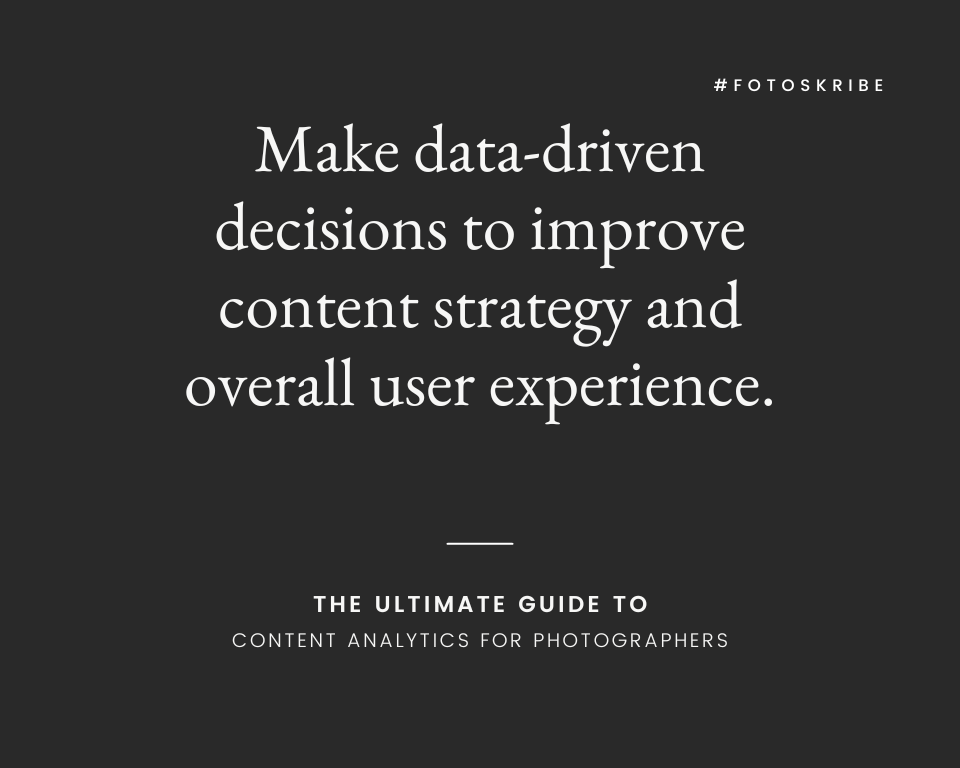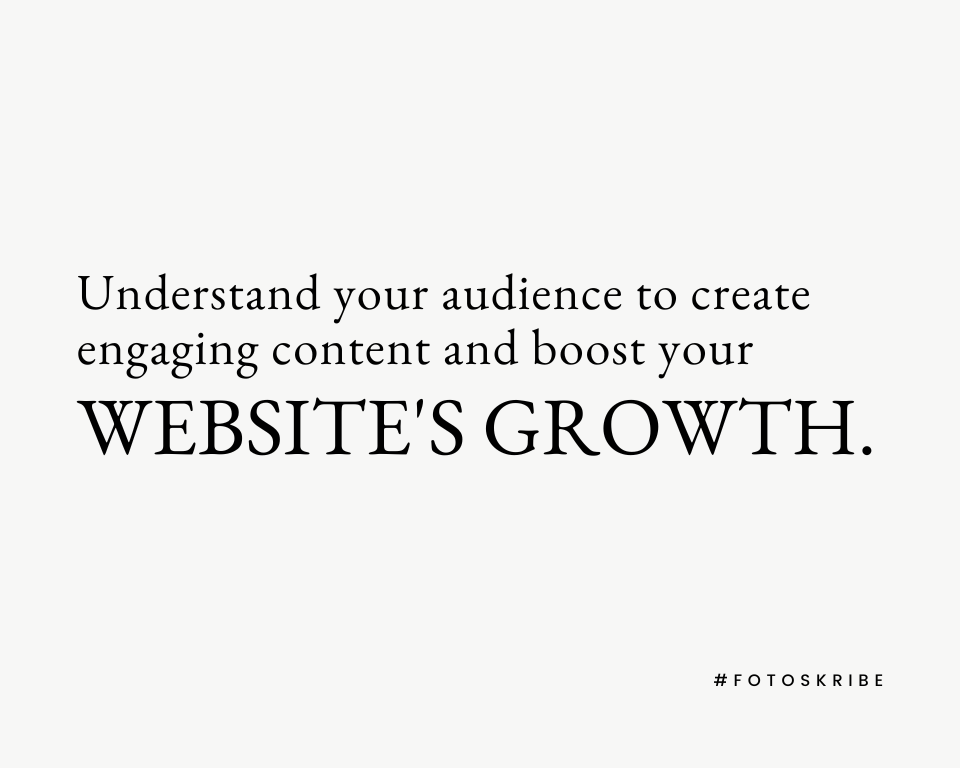The Ultimate Guide To Content Analytics For Photographers

Figuring out what kind of content clicks with your audience and whether your photography website is hitting the mark can be a real challenge, right? But fear not – content analytics is an invaluable research method used to provide insights into which types of published content work best and which don’t. This will help you make informed decisions about creating campaigns that really engage with your customers. In this blog post, we’ll explore how using data-driven metrics can be used to measure the effectiveness of your photography website and content so you know exactly where to focus your efforts in order to maximize performance!
Using Content Analytics To Measure Website Performance
1. Website Traffic Metrics

Website traffic metrics are a vital component of content analytics and play a critical role in measuring your website’s overall performance. Essentially, these metrics provide you with insights into how many people are visiting your website, what pages they are viewing, and how long they are staying on each page. Some of the most important website traffic metrics include the following:
- Sessions: These indicate the total number of visits to your website, including both new and returning visitors.
- Pageviews: It refers to the total number of times each page on your website has been viewed.
- Bounce rate: It refers to the percentage of visitors who exit your website after viewing just one page.
- Time on page: It indicates the average amount of time visitors spend on each page.
- Referral sources: These metrics reveal the sources of your website traffic, including search engines, social media, and other websites.
Make use of these tools to better understand how your website is performing. Plus, you can make informed decisions to enhance your content marketing strategy, user experience, and overall online presence.
2. Engagement Metrics
Engagement metrics are critical for analyzing the effectiveness of your website’s content and its ability to engage with your target audience. These metrics focus on how users interact with your website, including specific actions like clicking on links or completing a form. Some metrics that you should be tracking are as follows:
- Click-through rate (CTR): It measures how many users clicked on a specific link, image, or call-to-action (CTA) on your website.
- Engagement rate: This calculates the percentage of users who interact with your social media content, such as liking, commenting, or sharing.
- Average session duration: This indicates the average amount of time users spend on your website.
- Followers: The number indicates your social media account’s follower count.
- Impressions: This refers to the total number of times your social media content has been seen.
You can measure content performance metrics for your website using content analytics tools like Google Analytics or for social media; each platform provides its own set of engagement metrics. The insights from consumption metrics include likes, comments, shares, and retweets. They can then be used to create a content performance report that’ll help you tailor your content to your audience’s preferences and interests.
Suggested Read: Social Media Automation For Photographers: Automate Your Way To Success
3. Conversion Metrics

Revenue or Conversion metrics are critical for understanding the financial success of your website and its ability to generate revenue. These metrics focus on how many visitors to your website actually make a purchase or complete a specific goal, such as filling out a contact form, signing up for a newsletter, or making a purchase. Following are some of the most important revenue or conversion metrics for you to track:
- Conversion rate: It calculates the percentage of visitors who completed a particular action, like making a purchase or filling out a contact form.
- Revenue per visitor (RPV): It measures the average amount of revenue generated from each visitor to your website.
- Average order value (AOV): This indicates the average value of each transaction made on your website.
- Abandoned cart rate: It shows the percentage of users who added items to their cart but did not complete the checkout process.
Business analytics is used to track how content performance affects the bottom line, such as conversion rates, revenue generation, customer acquisition costs, cost per lead, and other important KPIs. You can measure conversion metrics using content analytics software to track content performances.
4. Search Engine Optimization Metrics
SEO metrics are crucial for understanding how your website is ranking on search engines and driving traffic to your site. These metrics measure how effectively your website is optimized for particular keywords and phrases that users search for on search engines. Some important SEO metrics for professional photographers are as follows:
- Organic search traffic: This measures the number of people who discovered your website through a search engine.
- Keyword rankings: These show how well your website is ranking for specific keywords and phrases on search engine results pages (SERPs).
- Backlinks: The number of websites linking to your website is an indication of how popular it is. This can improve your search engine rankings.
Google Search Console is a great analytics tool to measure your website’s search engine performance, including how many impressions and clicks your website receives from search results.
Suggested Read: Get Booked Faster: The Best Marketing Tips for Wedding Photographers
5. Audience Metrics

Audience metrics are critical for understanding your website’s audience and their behavior, preferences, and interests. These provide valuable insights into who is visiting your website, where they are coming from, and how they are interacting with your content. Here are some of the most important audience metrics for you to track:
- Demographics: This shows the age, gender, location, and other characteristics of your website visitors.
- New vs. returning visitors: It indicates how many visitors to your website are new versus those who have visited before.
- Interests: These reflect the topics and categories that your website visitors are interested in, which can help you tailor your content to their preferences.
- Behavior flow: It shows the path that users take on your website, including which pages they visit and how long they stay on each page.
Understanding your audience can help you create digital content that resonates with them and ultimately grow your business.
Further Read: The Best Content Repurposing Services By Fotoskribe
As a professional photographer, it’s crucial that you keep track of your content production stats to gauge your impact on the market and make informed decisions about optimizing your efforts. Real-time analytics like website traffic and audience engagement helps you understand your content effectiveness. And by leveraging content marketing analytics to measure your website’s performance, you can develop a successful business content strategy tailored to your audience’s preferences to increase revenue for your business. So, take the step to harness the power of content performance analysis and take their online presence to the next level.
At Fotoskribe, we aim to help businesses like yours grow their online presence by delivering smart and meaningful content that engages your audience. And we do it in a way that gets Google’s attention. For more information on how we can help – check out our pricing plans.
